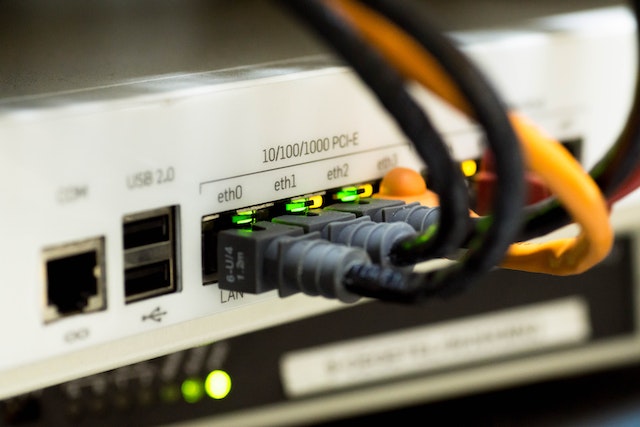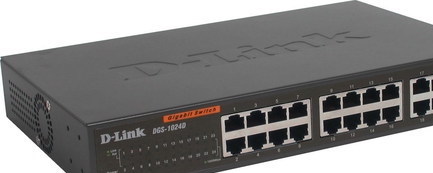Ethernet hubs let you connect multiple devices and share the information from one LAN device to another. Once it receives the information, it sends it out to all other devices that are connected to the hub. This ensures the data is transferred without any failure.
When too many PCs are connected to the Ethernet hub, its performance also takes a hit.
Continue reading as we go into great detail to give you all the details about the Ethernet hub, including how it functions, what it can do, and more.
What Is an Ethernet Hub?
Before we tell you about Ethernet hubs, we believe we should clarify that Ethernet hubs, Ethernet switches, and Ethernet routers are all different devices that often get confused. Each has its functionalities that serve other purposes.
Now that's out of the way, here's a brief explanation of an Ethernet hub.
An Ethernet hub helps in transferring data from one device to another after receiving the data. As a result, a hub is frequently utilized as a point of connection for all devices within a data network.
Every segment of the local area network, or LAN, can see every data packet because an Ethernet hub has multiple ports, which means that when a packet is received by one port, it is also sent to and received by other ports.

When the Ethernet hub receives a packet, it doesn't recognize where to send it to. Hence, it passes the packet to all ports to ensure it reaches its destination without fail.
This data management method is straightforward and efficient, but it creates a lot of network activity because each port is also loaded with a large amount of unnecessary data.
Types of Ethernet Hub and Its Uses
There are three types of Ethernet hubs: Intelligent hubs, Active hubs, and Passive hubs.
- Active hubs: Active hubs amplify the data packets that are carried by the incoming signals and act as repeaters. Also, you can configure your active hub as a firewall to monitor the data packets being received. Active network hubs enable resynchronizing if the receiving signal is too poor for rebroadcasting.
- Intelligent hubs: Intelligent hubs have the same functionality as active hubs but also support remote management.
- Passive hubs: Passive hubs' workings are the opposite of active and intelligent. They do not amplify incoming signals or LAN performance but set a cap on the maximum distance limit.
What Does an Ethernet Hub Do?
An Ethernet hub helps connect several LAN devices. Its only function is to send the information from one port to all the other ports connected to the Ethernet hub.
There are a few drawbacks to using an Ethernet hub. The first one would be that it can deliver lower network response times in a large workplace, but this is not much of a problem if it is for a small office or a home.
The second one would be that the ethernet hub shares its bandwidth with all available ports; this creates a huge performance issue when multiple PCs send out information. Every port will require extra bandwidth, leading to performance degradation.
Ethernet Hub vs. Ethernet Switch vs Ethernet Router: What Is the Difference?
With an Ethernet hub, you can connect multiple PCs to a single network and broadcast data signals to all the connected computers. An Ethernet hub doesn't require a MAC address as it is a simple and basic device that broadcasts the data signal to all the connected devices.
On the other hand, an Ethernet switch transmits the data to specific MAC addresses that share a single LAN. By using the CAM table, you can differentiate between different addresses using the CAM table and also remember the MAC addresses.

An Ethernet switch costs more than an Ethernet hub and only supports PCs, so large corporations do not use it because it doesn't support servers. The consumer market for ethernet switches is small offices that need help with their internet infrastructure.
Ethernet routers are an integral part of our everyday lives. If we didn't have a router, our smartphone and PC browsing activity would be minimal.
A router receives the signal from your ISP (Internet Service Provider) and then sends the signal across to wireless devices using antennas.

A few disadvantages of a router are its signal reach and internet speed. If you are within proximity of a router, you will have a stable signal. If you are away from the router, there is a high chance the signal will be reduced and so will the internet speeds.
The router is available in various price ranges. The more expensive one usually has more technology, functionalities, and a better signal range.
Final Words
An Ethernet hub is a fantastic device that transmits the data signal from one PC to another. It is affordable, but it can seem like a wrong decision to buy an Ethernet hub in a corporate environment. For small offices or homes, the Ethernet hub can send information across the devices connected to the hub.
The other downside to the Ethernet hub is that it requires lots of bandwidth and slows down when multiple PCs connected to the Ethernet hub relay data signals.
We hope this article helped you learn about the Ethernet hub and how it is different from an Ethernet switch, and more.
Was This Page Helpful?
Daisy is the Senior editor of the writing team for EaseUS. She has been working at EaseUS for over ten years, starting as a technical writer and moving on to being a team leader of the content group. As a professional author for over ten years, she writes a lot to help people overcome their tech troubles.
Related Articles
-
[Beginner Guide] What Is VMware? What Is It Used for?
 Daisy/2024-01-11
Daisy/2024-01-11 -
NAS vs. DAS: Which Is Better & How to Choose
 Larissa/2024-01-11
Larissa/2024-01-11 -
MacBook Pro Full Information | MacBook Pro Models, Features, and Comparison
 Dany/2024-01-11
Dany/2024-01-11 -
Windows Command Line Cheat Sheet (Online Table and PDF)
 Daisy/2024-01-11
Daisy/2024-01-11
